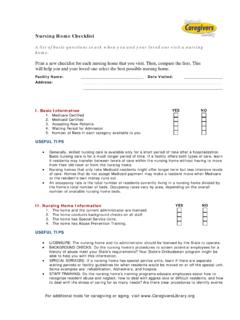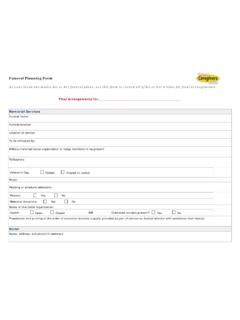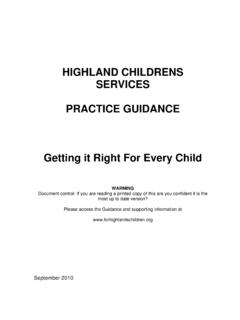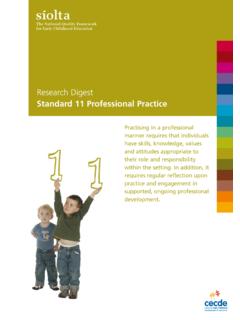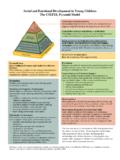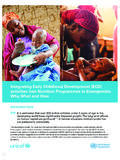Transcription of Supporting Employees with Child and Elder Care …
1 SupportingEmployeeswith Childand ElderCare NeedsA Work-Family Sourcebook for EmployersPortland State UniversityPortland, OregonJune 2001 Supporting Employees with Child and Elder Care Needs1 Table of Contents123A special case: Employees inThe sandwiched employeesWhat employers can outResources and responsibilitiesWhy employers should startedConducting a needs sourcebook is a product of a national study ofdual-earner sandwiched-generation couples, fundedby the Alfred P. Sloan Foundation (grant #96-10-20).Authors:Margaret B. Neal, , Institute on AgingLeslie B. Hammer, , Dept of PsychologyPortland State Universitywith Krista Brockwood,Suzanne Caubet, Cari Colton, Terry Hammond,Emily Huang, Jo Isgrigg and Angela RickardArtwork by PSU art students: Chris Chung (frontcover) and Jacie Kurkinen (back cover).
2 A Work-Family Sourcebook for Employers21 Family responsibilitiesWhy employersshould careNo one working a full-time schedulethese days not even a CEO is immuneto the enormous pressure of the demandsof responsibilities of family FaughtEmployee Benefit Plan ReviewFebruary 1999 Managing work life and family life hasbecome a major issue for much oftoday s workforce. Work and familypolicies have emerged as key competitive factorsfor businesses in the labor market. Why isthis? The answer is, in large part, the changingcomposition of the American workforce. More women, the traditional family care-givers, are entering or returning to the , women comprise about 46 percent of theworkforce, compared to about 37 percent in 1996 to 2006 the number of women in theworkforce is expected to increase by another 14percent.
3 The rising number of women in theworkforce has resulted in an increase in thenumber of families where both the husbandand the wife are 1996 and 1997, the number of dual-worker families in the grew by 352,000, whilethe number of traditional families (in which onlythe husband works) declined by 145,000. In 1999,dual-earner families accounted for 63% of allmarried-couple working families, compared to23% of married-couple working families in whichonly the husband worked, and in which onlythe wife worked. The number of single-parenthouseholds also has increased on a stay-at-home spouse to handlefamily responsibilities is not an option for mostfamilies.
4 The aging of the American population hasaffected both employers and the past century, the proportion of olderAmericans tripled. By 2030, 20% of Americanswill be 65 or older, and they will outnumberchildren under 18. Previous definitions of family as consisting of parents and their children, and dependent care as care only foryoung children,are changing. The fastest growing age group inthe is comprised of individuals aged 85 orSupporting Employees with Child and Elder Care Needs3older. with advanced age, proportionately morepeople experience health problems and limitationsand require assistance in performing activities ofdaily living.
5 Almost half of people aged 85+ needsuch are indeed providing help to their elders;about 80% of the care needed by elders is providedinformally by family and friends. The 1997 National Study of the Changing Workforce foundthat fully 42% of the workforce expects toprovide Elder care within the next five years. A1997 study by the National Alliance of FamilyCaregivers (NAC) and the American Associationof Retired Persons (AARP) found that just over23% of households consisted of at least oneperson who was currently caring for, or had in theprevious year cared for, a relative or friend whowas aged 50 or over.
6 About 64%, or millioncaregivers, were employed full or part time. Ofthe caregivers nationwide, 41% also had childrenunder the age of study by Neal and colleagues of Employees in33 different companies in 1993 (N=9,573),similarly found that 42% of the Employees whowere caring for elders also were caring forchildren. This group comprised 9% of the sampleof Employees overall. People who have caregiving[T]he rate of absenteeism has increasedmore than 14 percent since 1992. Onaverage, absenteeism costs $603 peremployee .. And more absences arenow being attributed to familyresponsibilities and personal MartinezHR Magazine, June 1997responsibilities both for dependent children andfrail or disabled parents have been dubbed the sandwich generation, in that they aresandwiched between the needs of their childrenand their parents, and often, their brief,employers are seeing increasing numbersof Employees of both sexes with one or morecaregiving roles for children, adults withdisabilities, and/or elderly parents or other are the work-relatedimplications of Employees increasedfamily responsibilities?
7 Employees caregiving responsibilities can havea variety of negative impacts on Employees has demonstrated, for example, thathaving these duties can be associated withdecreased productivity, increased absenteeism,increased intentions to quit, decreased job satis-faction, increased mental and physical healthproblems, increased substance abuse, andincreased stress and strain. This snapshot oftoday sworkforce, its caregivingresponsibilities, andtheimpact of those responsibilities demonstrates theneed for employers to consider these it hits home, it tends to be viewedas someone else s issue, butdemographics will change that and puteldercare on a lot more employers Elder care will be to the 21stcentury what Child care was to the lastfew Ruddock, Vice PresidentMetlife s Long-Term Care GroupHR Magazine, May 2000A Work-Family Sourcebook for Employers4 The Business Case:Why provide work-family supportto Employees ?
8 When companies support their Employees in theirefforts to manage both work and family, there canbe many positive outcomes for both parties. Forexample, research has found that management srecognition of the importance of an employee spersonal and family life is the most significantdriver of employee commitment. In 1994,interviews conducted with human-resource vicepresidents and directors of 71 Fortune 500corporations, revealed the benefits that thosecompanies accrued from their commitment tohelping Employees deal with work-family companies felt that such assistance improvedrecruitment and retention (mentioned by 41% ofthose interviewed), improved morale (mentionedby 21%), reduced stress that lowers productivityand service quality (mentioned by 18%), andhelped companies to keep up with their competi-tion (mentioned by 15%).
9 Indeed, findings from this study and othersindicate the following benefits to employers ofhelping Employees manage their work-familyresponsibilities: decreased absenteeism reduced turnover improved recruitment potential improved retention improved job satisfaction improved organizational commitment improved morale more consistent productivity improved physical and psychologicalwell-being of has found that companies can get a $3to $13 return on every $1 invested in their benefitsprogram, because such programs reduce the hidden costs that result when Employees try tobalance their work and family include costs due to unplanned absences;turnover/recruiting/retraining; extended caregiverleave.
10 And workday example, business experts consistentlyestimate that the cost of replacing an employee isone half his or her existing salary plus the entrysalary of the replacement employee . These hiddencosts can add up to 5-12% of the company recent profitability analysis of the top 100family-friendly companies concluded that offeringan optimal family-friendly benefits package thatis designed to match the demographic needs ofthe workforce can, in fact, increase profits. Thisstudy also concluded that the mere presence of awork-family benefit program had positive effectson organizational outcomes, regardless of actualemployee supports andemployers todayAs noted previously, some employers haverecognized the need for greater work-familyawareness if they are to remain competitive in thelabor market.


